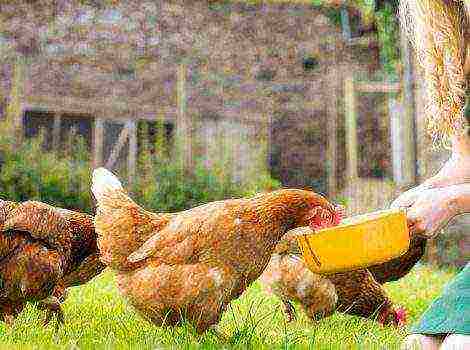Content
Broiler chick care and feeding
Growing broiler chickens of high yielding beef breeds continues to gain popularity. Proper care, balanced feeding, adherence to all veterinary rules allows you to get high-quality dietary products at your personal backyard in just 30-40 days.
How to choose broiler chicks
When choosing broiler chickens, several factors: cross (breed), producer and price, age and vitality.
Breeds (crosses)
Broilers - the result of purposeful breeding work to breed a hybrid to quickly obtain high-quality dietary meat products.
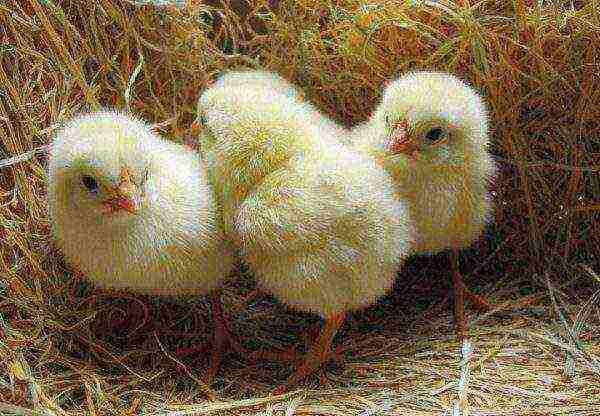
Most popular Russian poultry farmers have broilers of the KOBB-500, ROSS-38, 708, Gibro-6, Broilers-61, M. Krossy Smena and Hubbard F 15 crosses.
Manufacturers
It is safer to buy broiler chickens from reputable private farms and specialized hatchery stations... As a rule, chicks purchased from such producers are viable, active and already vaccinated against major diseases.
Broiler price offered by large poultry farms below, but there is a vicious practice of selling culled weak young animals by factories.
The cost of chickens varies depending on age, breed, region, season from 35 to 95 rubles Per head.
Age
Cheaper day-old chicks are preferred by experienced poultry farmers who know the intricacies of keeping and have equipped areas for growing.
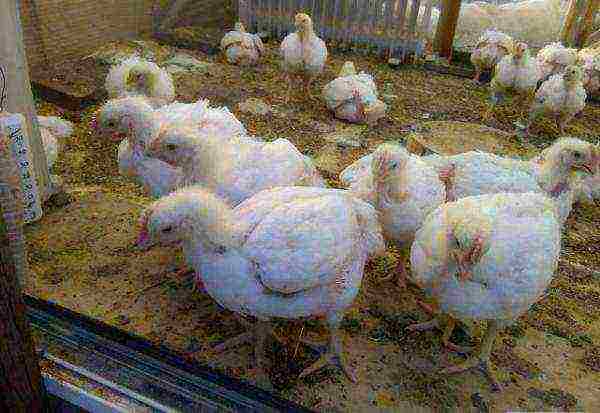
For beginners it is recommended to purchase young animals at the age of 5-10 days, since it is easier to care for them.
Viability
Healthy, viable broiler chicks are selected according to the following signs:
- Chickens are active, mobile, react to sounds, with good appetite.
- Clear eyes with glitter.
- Soft tummies.
- Wings tightly pressed to the body.
- Feathers on the wings of cockerels of the same length.
- Absence feces on plumage.
- Smooth pubescence, without "scraps".
Feeding
On average, about 4 kg of feed is consumed to obtain marketable poultry. In the first two weeks the chick receives 35-38 g of feed per day, the daily allowance for two to four weeks will be 100 g, then 150 g.

The most effective for growing in a home or farm environment is recognized combined feeding method... With the constant presence of compound feed in the feeders, wet feed is given to the bird twice a day, grain is poured overnight.
Everything for combination feeding
- Dry industrial compound feed... When selecting ready-made compound feeds, it is recommended to carefully study the composition and quality. Most of the feeds produced in Russia and the near abroad do not comply with the accepted GOSTs.
- Dry food from grains of wheat, corn, barley, legumes, milling grains and legumes.
- To reduce the cost of production in private farmsteads, they successfully use food waste - dairy (reverse, whey, yogurt, cottage cheese), fish, meat, fruit (apple, pear, banana and others), garden products (small roots, frozen potatoes). They feed harmful insects and their larvae (May and Colorado beetles).
- Zelenka - nettle, alfalfa, clover, dandelions in crushed form, peel tops, pulp of carrots, beets, zucchini, pumpkin, cabbage leaves.
- Additives - vitamin complex supplements, meat and bone and fish meal, eggshell, shell rock, table salt.
- Wet mash.

Drinkers should always have clean, fresh water. Should be observed temperature regime:
- Chicks 1-3 days life is watered with water t +33 C °.
- On the 4-7 day t +30 С °.
- From day 8 life weekly reduce the temperature of the water by 2 °.
- Stop at t +20 С °
Age ration
Differs in the periods of physiological development of broilers.
Distinguish:
- Starting, primary diet (up to 2 weeks of age).
- Fattening (during the period of active development and growth).
- Finishing with a low percentage of protein (grown young, adult poultry before slaughter).
Day-old chicks
Aged up to 5 days chickens receive either a ready-made growth compound feed, or feed containing up to 50% of products saturated with carbohydrates and proteins. These include grain mixes (crushed grain of wheat and corn, boiled millet, barley and oats without films), wet mash.

From the 2nd day finely chopped chicken eggs are introduced into the diet of the chicks. Two boiled eggs are enough for 50 chickens. They give quail eggs, cottage cheese, vitamins A, E, D3 in the form of a drug such as Trivitamin.
Feeding frequency during this period, every two hours, at least 5, preferably 8 times a day.
Dry feeding 3-4 times is enough. Morning feeding is done as early as possible, evening feeding as late as possible.
Weekly chicks
At one week of age diet enrich... As an anti-rachitis agent for 5-7 days in a flour mixture, add wet mash of 0.1-0.2 g per chicken fish oil... Gradually, finely grated carrots, gruel of nettle leaves, dandelions, flour made from chalk, shell rock or calcined eggshells, fish waste, recycled meat are introduced into the diet.

Experienced poultry farmers recommend breeding mash dairy derivatives, give chickens a small amount of boiled potatoes, sunflower, soybean cake, corn, wheat turf (mill grain without special cleaning).
Feeding frequency - 6 times a day. With a balanced diet, broiler chickens gain weight of 500-700 g by the age of one month.
Weakened chickens are supported raw yolk stirred in milk. The yolk is injected into the beak using a pipette 8 times a day. 11 day chicks must feed on their own.
Monthly chicks
At the age of one month, broiler chickens are transferred to protein-rich food.
Mash from a mixture of equal parts of crushed corn, wheat, peas, barley, dilute with meat broth, add more fish and meat waste, meat and bone, fish, grass meal, dairy products, green mass. Welcomed peanut and sunflower meal, sprouted grain.
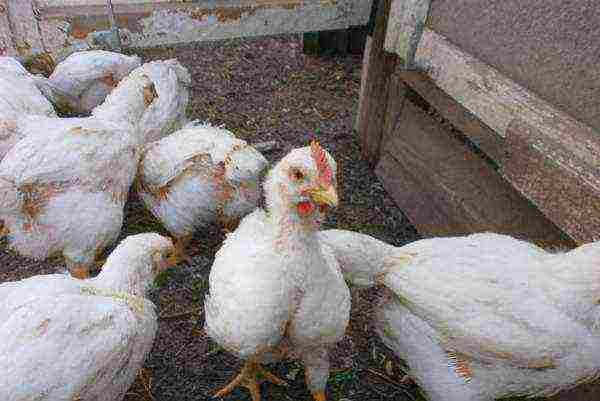
In the diet of monthly young animals, the presence of baker's yeast - at least 2 g daily per head, fish oil, ready-made dry vitamin mixtures. Vitamin D is additionally given in winter.
The feed must be renewed every 2 hours, it must be fresh, not windy.
In summer, they provide the opportunity to receive 50 or more percent of the daily allowance pasture... This not only reduces maintenance costs, but also increases the immunity of young animals, the nutritional and taste value of meat.
Feeding frequency 7-8 times.
Immediately before slaughter, broilers are transferred to finishing food.
The transition to whole grain is underway. As supplements offer brilliant green. The mash is diluted with meat broth, boiled potatoes are added to them.
The feed is stored in tightly closed metal, plastic containers.
When buying ready-made mixtures, compound feeds are carefully observed storage periods.
Maintenance and care at home
In the conditions of home, farm raising of broiler chickens, proper maintenance and care... It is necessary to properly equip the premises, observe veterinary and zootechnical norms, show constant care and attention to the growing chicks.

Chicken coop, cages, litter, street
There are two breeding routes broiler chickens: intensive and extensive.
- Intensive (production) maintenance consists in limiting the movement of broiler chickens from the moment they hatch with a cage or deep floor bedding and feeding the chickens with high-grade dry compound feed.
- At extensive way cultivation, the most acceptable for a peasant or farm economy, the bird is kept in equipped chicken coops, cages, moves freely around the range, receives a variety of type and composition of feed.
At "Free" keeping poultry is equipped with a poultry house. Daily chicks and marketable birds require square at the rate of 12-15 heads per 1 m².
At cellular up to 18 broilers are placed on 1 m², but the meat of such birds will be denser and tougher. There are several options for cells that are made independently or purchased ready-made. The cells are assembled in a cassette or battery-like structure.

Most private poultry breeders prefer outdoor way growing in a chicken coop on a litter. For this, the floors are covered with sawdust, straw, shavings, fibrous peat. To comply with sanitary and hygienic standards, damp lumps are regularly removed, mixed and added with filler.
IN summer period growing broiler chicks and adult chickens are released outside into a fenced-in range. If the walk is well protected from drafts, for example, by previously used window, greenhouse frames, chicks are released on the "grass" from the age of one month.
Temperature regime
Broiler chicks require strict adherence temperature and humidity in places of detention. Humidity throughout the growing period should be in the range of 60-70%.
For heating household and industrial heaters, infrared lamps are used.
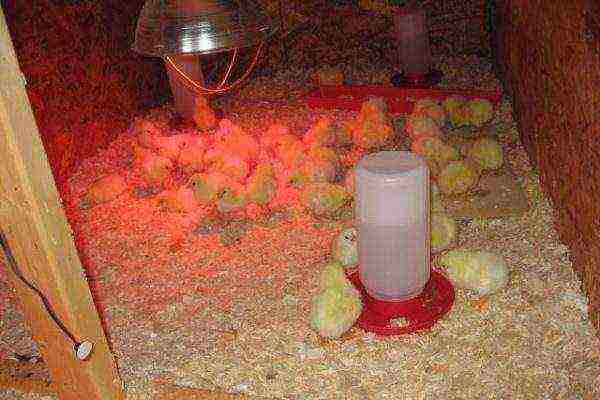
Day-old chicks enclose, limiting their distance from the heat source, maintaining t + 32 ° -35 ° С. From the second week a gradual decrease in temperature begins. 6-10 day old chicks t + 32 ° -30 ° C is required. 11-20 days - t + 28 ° -26 ° С. Beginning from the third week t + 24-20 ° C is required.
Lighting
Until the 5th day the coop is lit for 20-24 hours. IN week of ageWhen the chickens begin to distinguish between day and night, they begin to interrupt the lighting for 10-15 minutes every 2 hours, gradually bringing daylight hours to 16-17 hours.
Ventilation
In the poultry house, you need to equip ventilation, extractor hood. A constant supply of clean air is vital for broilers.
Feeders and drinkers
Before reaching weeks of age the trough is filled to the brim. Once the chicks acquire self-feeding skills, feeders and drinkers ¼ filled and raised above floor level to avoid food contamination of the litter.
Raise broiler chicks profitable... Observing simple requirements, you can not only provide a family with environmentally friendly, dietary chicken meat, but also to achieve a small benefit in the sale of broiler meat.
